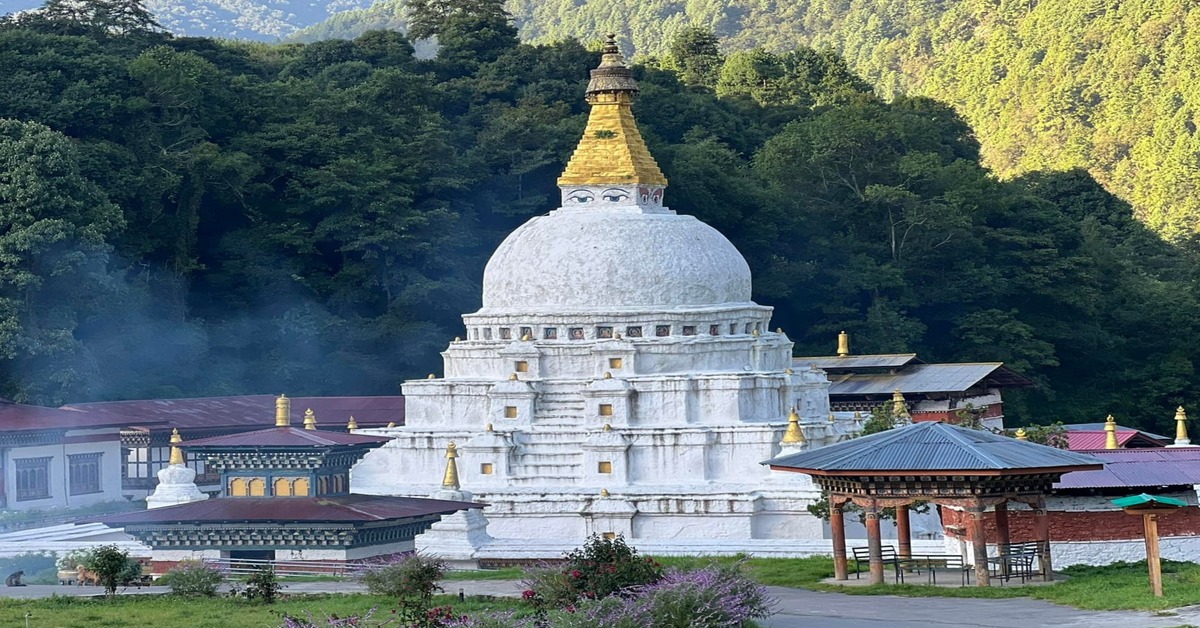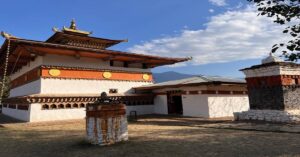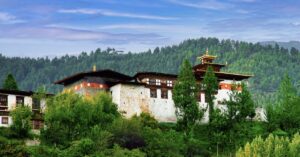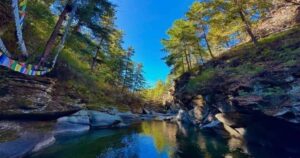Chorten Kora is a replica of the historical Boudhanath Stupa built by Lama Ngawang Loday, the 3rd abbot of Rigsum Goenpa, and the nephew of Zhabdrung Ngawang Namgyal in 1740 AD. It is located near Kholongchu at the base of the Yangtse Valley in Trashiyangtse Dzongkhag at an altitude of 1725 meters.
The Stupa, modeled after the Boudha Stupa in Nepal, was built in memory of his late uncle, Lam Jangchub Gyeltshen, and to subdue a demon believed to have been living at the site and terrorizing the people. It took 12 years to construct and was consecrated by Je Yonten Thaye. The Choeten was originally named Duerong Choeten, but later became more popular as Choeten Kora.
The Bhutanese and Dakpa people from Mon Tawang gather in spring for the Chorten Kora Tshechu festival to circumambulate the great stupa. Today, Chhorten Kora has become an important pilgrimage site in Trashiyangtse.
Chorten Kora is important as a revered stupa built in 1740 to subdue local spirits, honor a self-sacrificing Dakini girl, and foster harmony between Bhutanese and neighboring communities of Arunachal Pradesh.
How to Reach Chorten Kora
Chorten Kora is located in Trashiyangtse. It is 513 kilometers from Thimphu, the capital city. You can also avail of air service from Paro International Airport to Yongphulla Domestic Airport in Trashigang. Yangtse town is a 2-hour drive from Trashigang. From there, it’s three minutes to the great stupa of Choeten Kora.
Sacred Relics to See at Choeten Kora
- A replica of the Boudha Stupa;
- The original stone pinnacle (Sertog) of Chorten Kora;
- Chorten Kora Tshechu;
- Dakpe Kora or Tse-Chenga Kora;
- Drukpe Kora or Namgang Kora.
Also Read: Guru Rinpoche in Bhutan: His Visits to Bhutan and Sacred Sites
Historical Significance of Chorten Kora
According to the history of Chorten Kora, in the olden days, where the Chorten Kora stands today, the demons appeared both day and night, torturing and taking the lives of the people traveling via Duerong Drak. No travelers would dare to cross alone even during the daytime. The place was called Dhud Rong, or the Valley of Demons. So, the people of upper, middle, and lower Kholong in unison requested the Lama Ngawang Lodro, the 3rd Chief Abbot of Rigsum Gompa, to find a solution to subjugate demons.
Lama Ngawang Loday proposed constructing a replica of the Boudhanath Stupa of Nepal, popularly known as Jarung Khashor. The Boudha stupa is believed to have been built by Guru Rinpoche and his brothers (King Thrisong Deutsan of Tibet and Vairocana) in their previous lives.
Therefore, to begin the task, Lama Ngawang Loday went to Bodnath, Nepal. He visited the stupa, crafted a model from a radish, and returned home with the radish model. However, by the time it arrived at Trashiyangtse, the radish model had shrunk, distorting the shape. Thus, the Choeten Kora underwent some changes in design. It is distorted at the gallery level, as seen even today.
Lama Ngawang Loday constructed the stupa with the support of his disciples and devotees from Trashi Yangtse, Trashigang, Kurtoe Valley, Zhongar, and Dungsam, as well as the people of Dhakpa La-Wog Tsho-sum from Mon Tawang.
When the construction of the Choeten reached its dome, the local people looked for a Dakini to enshrine the dome to amplify its protective powers and appease a ferocious demon. Driven by destiny, a 16-year-old girl with all signs of Khandroma, clean and untouched by any man from Mon Tawang, was enshrined in this stupa.
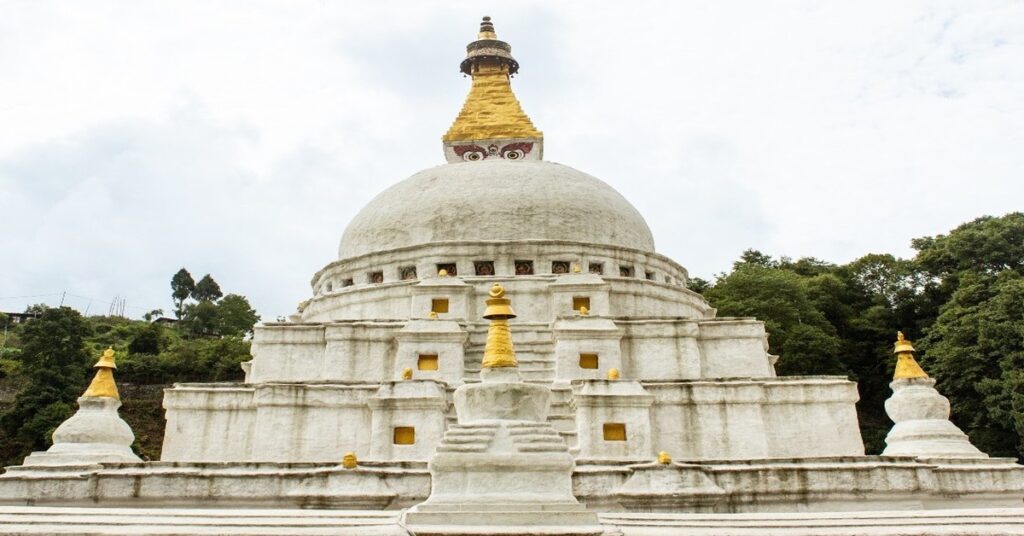
Description of Choeten Kora
The great stupa of Dhuerong, commonly known as Chorten Kora, is a replica of the Boudha stupa in Nepal. However, it is not as large as the Boudhanath stupa, as the radish model is said to have shrunk when it reached Trashiyangtse. The stupa is 44 meters high and 22 meters square at its base.
Choeten Kora has eyes painted facing in four cardinal directions. Three of these eyes are alike, but the one that faces the cliff has a frightful appearance. This specific appearance represents protection and awareness, which is thought to ward off evil spirits.
Geduenpa, the Dzongpon of Trashiyangtse, built enclosing walls on all four sides upon the advice of Lam Ngawang Lodoe. Desheg Choeten gey, or the 8 different stupas, are built on these walls, and a hand-rotating mani is installed beneath the wall face. In 2001, the Trashiyangtse Dzongkhag rebuilt the stone-slab roofing of the enclosure of the Choeten and prayer wheels.
In front of the Chorten Kora is the original stone pinnacle, or the Sertog, carved out of a huge stone. It is considered sacred. Pilgrims and devotees who circumambulate the Choeten also go around the original stone pinnacle. Legend has it that when the 6th Rigsum Goenpa Lam, Shacha Gyalpo, wanted to replace it with a gilded cupola, people involved in the work could not bring down the stone pinnacle. So, he offered his request to the self-spoken Buddha- Jowo Sunjoem of Rigsum Gonpa the whole day. That night, the stone pinnacle miraculously descended to the ground where we see it today. It is believed to be the work of Khandroms.
Rigsum Gonpa maintained Chhorten Kora with support from the public and devotees in the past. Trashiyangtse Dzongkhag took over in 1988, and the golden cupola was gilded again in 1999.
Chorten Kora Tshechu Festivals
Chorten Kora Tshechu festivals involve two koras, the Dakpe Kora and the Drukpe Kora, during the first month of the lunar calendar. The festival is to circumambulate the chorten and doesn’t have mask dance performances. The Chhorten is whitewashed a month before the festival.
The first kora, Dakpa Kora, or the circumambulation by the Dakpas of Mon Tawang, is an annual festival held on the 15th day of the 1st month of the Bhutanese calendar. It is also called Tse-Chenga Kora, the circumambulation of the Chorten on the 15th day. This festival is observed in memory of the young Tawang girl who offered herself as the inner relic of the stupa. For this reason, hundreds of Dakpa people from Tawang visit this chorten annually to circumambulate and commemorate the sacrifice of the prince of Tawang.
The second kora, Drukpa Kora, or the circumambulation by the Bhutanese, is an annual festival for the Bhutanese held on the 30th day of the same month. The festival commemorates the successful completion and consecration of Chorten Kora on this day in 1752. It is also known as Namgang Kora, the circumambulation of the Chorten on the 30th day.
During the festival, a giant Thongdrel is unfurled to the public. Ten days later, Gomphu Kora hosts a similar festival called Gomphu Kora Tshechu.
Also Read: The popular Drakarpo Kora in Paro
Best Time to Visit Chorten Kora
The best times to visit Trashiyangtse Dzongkhag in Bhutan are spring (March to May) and autumn (September to November). These seasons offer pleasant weather and vibrant landscapes, making them ideal for sightseeing and outdoor activities. However, the perfect time would be during the Chorten Kora festival in early spring. You can visit the major pilgrimage sites of Trashiyangtse with the Bhutan Pilgrimage Package.
Places to Explore in Trashiyangtse
Gomphu Kora: Known as Gom Kora, is a sacred pilgrimage site where Guru Padmasambhava meditated in a rock cave and subdued an evil spirit in the 8th century.
Omba Ney: Often referred to as the “Taktsang of the East,” this is a significant pilgrimage site in Trashi Yangtse. The prominent Mantra “OM” is visible on the rock faces, and there are stunning cliffside temples.
Gongza Ney: A revered site where Khandro Yeshey Tshogyal offered him tea at noontime.
Rigsum Goenpa: A monastery founded in the 18th century by Lama Tshering Gyamtsho, which guards Bhutan’s sovereignty from the north.
Pemaling Ney: A holy pilgrimage destination where Guru Rinpoche had meditated.
Dechenphodrang Ney: A hidden place of peace and refuge blessed by Guru Padmasambhava in the 8th century.
Enjoyed reading this blog?

